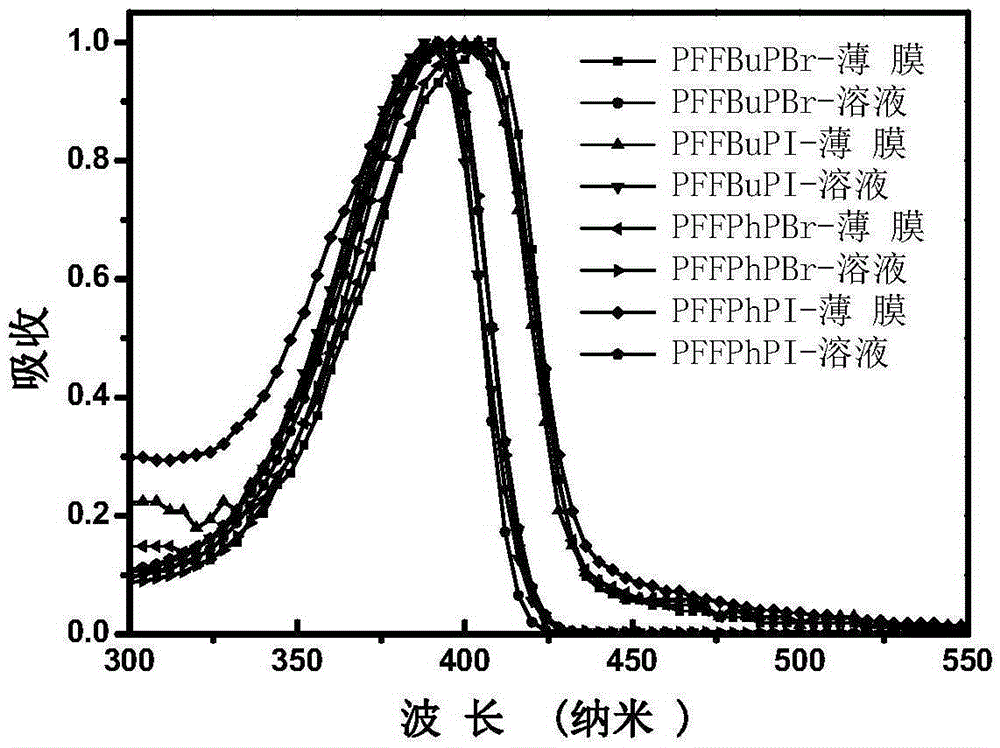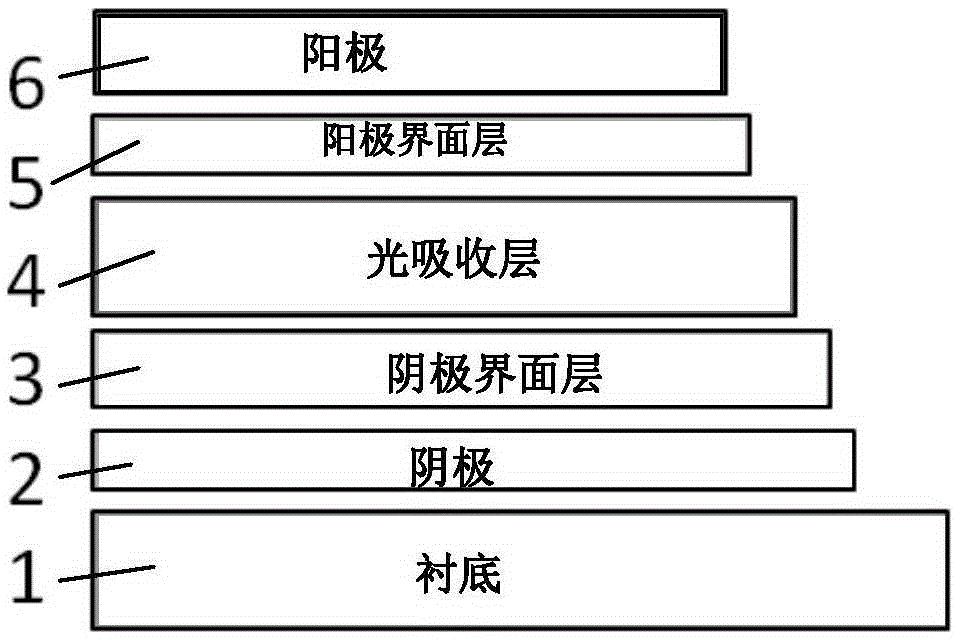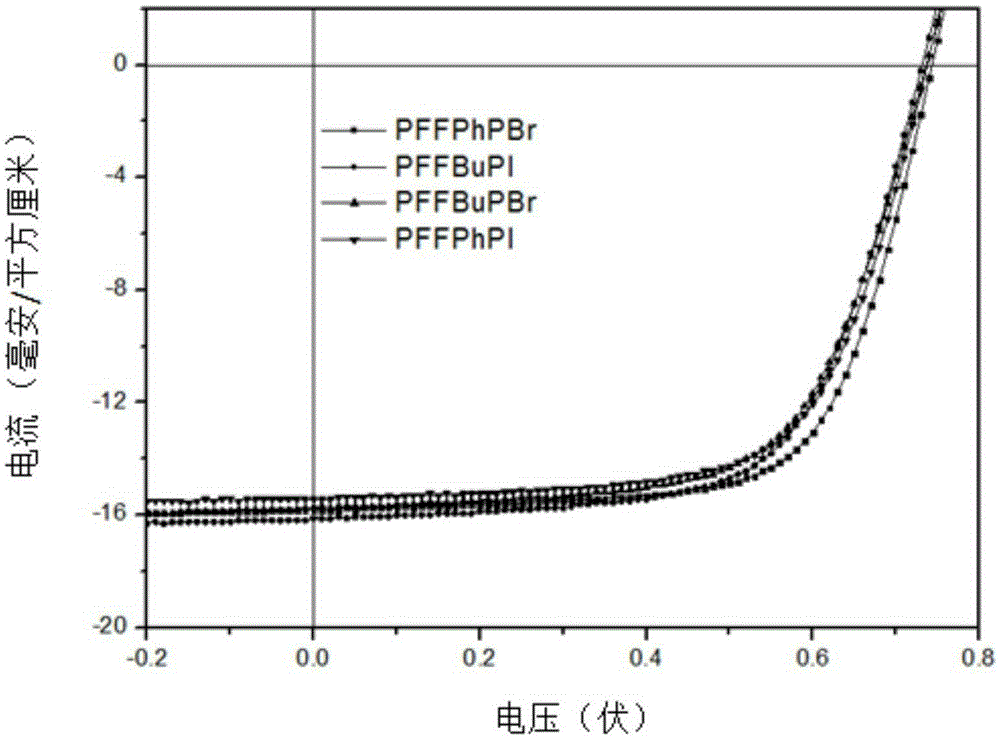Quaternary phosphonium salt group-containing conjugated polyelectrolyte and its use in organic photoelectric device
A conjugated polyelectrolyte, quaternary phosphonium salt technology, applied in the direction of electric solid devices, electrical components, semiconductor devices, etc., can solve the problems of high energy consumption, high price, large-scale application limitations, etc., to improve energy conversion efficiency, improve Fill factor, effect of excellent charge extraction performance
- Summary
- Abstract
- Description
- Claims
- Application Information
AI Technical Summary
Problems solved by technology
Method used
Image
Examples
Embodiment 1
[0036] Synthetic routes of representative conjugated polyelectrolytes containing quaternary phosphonium salt groups The synthetic routes of PFFPhPBr, PFFPhPI, PFFBuPBr and PFFBuPI are as follows:
[0037]
[0038] (1) Monomer M1 was synthesized according to the method disclosed in literature [J.Am.Chem.Soc., 2013, 135, 15326].
[0039] (2) Monomer M2 was synthesized according to the method disclosed in literature [Macromolecules 1997, 30, 7686].
[0040] (3) Synthesis of polymer PFFBr:
[0041] Add 650 mg of monomer M1 and 643 mg of monomer M2 into a 25 mL two-necked flask, pass through nitrogen protection, add 8 mL of toluene and 4 mL of deionized water, add 850 mg of anhydrous sodium carbonate, and then add two drops of A336 (methyl trioctyl chloride ammonium chloride solution). Add 5mgPd(PPh 3 ) 4 , After reacting at 95°C for 12h, the polymer was precipitated with methanol and washed three times. 802 mg of polymer was obtained, and the yield was 90.7%.
[0042] (4)...
Embodiment 2
[0052] The conjugated polyelectrolytes PFFPhPBr, PFFPhPI, PFFBuPBr and PFFBuPI synthesized in Example 1 containing quaternary phosphonium salt groups were used as cathode interface modifiers in organic solar cells. The structure of organic solar cells is as figure 2 As shown, the sequence is: substrate 1 / ITO cathode 2 / cathode interface layer 3 / light absorbing layer 4 / anode-machine interface layer 5 / anode 6. The conjugated polyelectrolyte of the present invention is used as the cathode interface layer 3 in organic solar cells.
[0053] Pre-cut the ITO conductive glass with a square resistance of 20 ohms / cm2 into 15mm×15mm square pieces. Use acetone, special detergent for micron-sized semiconductors, deionized water, and isopropanol to clean ultrasonically in sequence, blow nitrogen whistle, and place in a constant temperature oven for later use. Spin-coat a layer of 5nm-thick conjugated polyelectrolyte containing quaternary phosphonium salt groups on ITO, then spin-coat the a...
Embodiment 3
[0055] Using the conjugated polyelectrolytes PFFPhPBr, PFFPhPI, PFFBuPBr and PFFBuPI synthesized in Example 1 as the cathode interface modification material in organic solar cells (ITO / ZnO cathode / cathode interface layer / active layer / anode-machine interface) layer / anode).
[0056] Pre-cut the ITO conductive glass with a square resistance of 20 ohms / cm2 into 15mm×15mm square pieces. Use acetone, special detergent for micron-sized semiconductors, deionized water, and isopropanol to clean ultrasonically in sequence, blow nitrogen whistle, and place in a constant temperature oven for later use. Spin-coat a layer of 40nm ZnO prepared by sol-gel method on ITO, then spin-coat a layer of 5nm-thick conjugated polyelectrolyte containing quaternary phosphonium salt groups on ZnO, and then spin-coat the active layer material PTB7, the thickness 100nm, finally evaporated MoO 3 and Al electrodes. All preparations were carried out in a glove box under a nitrogen atmosphere. The current-v...
PUM
 Login to View More
Login to View More Abstract
Description
Claims
Application Information
 Login to View More
Login to View More - R&D
- Intellectual Property
- Life Sciences
- Materials
- Tech Scout
- Unparalleled Data Quality
- Higher Quality Content
- 60% Fewer Hallucinations
Browse by: Latest US Patents, China's latest patents, Technical Efficacy Thesaurus, Application Domain, Technology Topic, Popular Technical Reports.
© 2025 PatSnap. All rights reserved.Legal|Privacy policy|Modern Slavery Act Transparency Statement|Sitemap|About US| Contact US: help@patsnap.com



